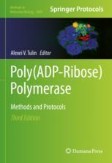Search
Search Results
-
PARP1 and XRCC1 exhibit a reciprocal relationship in genotoxic stress response
PARP1 (aka ARTD1) acts as a prime sensor of cellular genotoxic stress response. PARP1 detects DNA strand breaks and subsequently catalyzes the...

-
XRCC1 protects transcription from toxic PARP1 activity during DNA base excision repair
Genetic defects in the repair of DNA single-strand breaks (SSBs) can result in neurological disease triggered by toxic activity of the...

-
Promoter CpG island hypermethylation and down regulation of XRCC1 gene can augment in the gastric carcinogenesis events
Gastric cancer (GC) is a multistep process characterized by a gradual accumulation of genetic and epigenetic alterations in genes at various stages...

-
Genetic polymorphisms of GSTP1, XRCC1, XPC and ERCC1: prediction of clinical outcome of platinum-based chemotherapy in advanced non-small cell lung cancer patients of Bangladesh
Inter-individual genetic makeup can trigger variability in platinum-based chemotherapeutic responses and corresponding adverse drug reactions and...
-
Deficient DNA base-excision repair in the forebrain leads to a sex-specific anxiety-like phenotype in mice
BackgroundNeuropsychiatric disorders, such as schizophrenia (SZ) and autism spectrum disorder (ASD), are common, multi-factorial and...

-
Effect of Human XRCC1 Protein Oxidation on the Functional Activity of Its Complexes with the Key Enzymes of DNA Base Excision Repair
Base excision repair (BER) ensures correction of most abundant DNA lesions in mammals. The efficiency of this multistep DNA repair process that can...
-
Analysis of Copy Number Variation of DNA Repair/Damage Response Genes in Tumor Tissues
Cells experience increased genome instability through the course of disease development including cancer initiation and progression. Point mutations,...
-
DNA repair genes hOGG1, XRCC1 and ERCC2 polymorphisms and their molecular map** in breast cancer patients from India
Identification of modifier genes predisposing to breast cancer (BC) phenotype remains a significant challenge and varies with ethnicity. The genetic...

-
Role of Oxidation of XRCC1 Protein in Regulation of Mammalian DNA Repair Process
AbstractThe influence of XRCC1 protein oxidation on the modification of proteins catalyzed by poly(ADP-ribose)polymerases (PARP1 and PARP2) was...

-
Genetic Variant XRCC1 rs1799782 (C194T) and Risk of Cancer Susceptibility in Indian Population: A Meta-analysis of Case–Control Studies
X-ray repair cross-complementing group 1 (XRCC1) plays a key role in the base excision repair pathway, as a scaffold protein that brings together...

-
Quantitative Analysis of Nuclear Poly(ADP-Ribose) Dynamics in Response to Laser-Induced DNA Damage
Poly(ADP-ribose) (PAR), catalyzed by members of the poly(ADP-ribose) polymerase family of enzymes, is a posttranslational modification with a...
-
DNA Methylation Profiling in Aneurysm and Comorbid Atherosclerosis of the Ascending Aorta
AbstractAtherosclerosis and aneurysm of the aorta are relatively common pathological conditions that remain asymptomatic for a long period of time...

-
Exploring homologous recombination repair and base excision repair pathway genes for possible diagnostic markers in hematologic malignancies
Hematologic malignancies (HMs) are a collection of malignant transformations, originating from the cells in the bone marrow and lymphoid organs. HMs...

-
Influence of the Poly(ADP-Ribose) Polymerase 1 Level on the Status of Base Excision Repair in Human Cells
AbstractBase excision repair (BER) is aimed at repair of damaged bases, which are the largest group of DNA lesions. The main steps of BER are...

-
Generation of C-to-G transversion in mouse embryos via CG editors
Base editors (BEs) are efficient and precise tools for generating single base conversions in living organisms. While most BE systems are limited in...

-
Purification and Characterization of Human DNA Ligase IIIα Complexes After Expression in Insect Cells
With improvements in biophysical approaches, there is growing interest in characterizing large, flexible multi-protein complexes. The use of...
-
SIRT1 deacetylated and stabilized XRCC1 to promote chemoresistance in lung cancer
Chemoresistance is one of the most important challenges in the clinical management of lung cancer. SIRT1 is a NAD dependent protein deacetylase and...

-
Lack of association between functional polymorphism of DNA repair genes (XRCC1, XPD) and clinical response in Indian chronic myeloid leukemia patients
The resistance for the tyrosine kinase inhibitors in chronic myeloid leukemia (CML) occurs mainly due to BCR/ABL1 dependent and independent...

-
ARL6IP5 reduces cisplatin-resistance by suppressing DNA repair and promoting apoptosis pathways in ovarian carcinoma
Ovarian carcinoma (OC) is the most lethal gynecological malignancy due to frequent recurrence resulting from cisplatin-resistance. ARL6IP5 is a novel...

-
Evaluation of DNA Damage and Expressions of DNA Repair Gene in Occupationally Lead Exposed Workers (Jodhpur, India)
Occupational exposure to lead (Pb) remains a significant concern for worker’s health working in different factories. There are many discrepancies...

